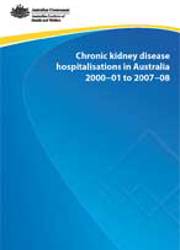Summary
People with chronic kidney disease (CKD) require extensive hospital services, particularly those patients with end-stage kidney disease (ESKD) who require kidney replacement therapy to survive. This report examines hospital usage for the treatment of CKD, and how this varies with different population groups.
The main findings
- Overall, CKD contributed to 15% (nearly 1.2 million) of all hospitalisations in Australia, one million of which were for regular dialysis.
- Indigenous Australians were hospitalised at 11 times the rate of other Australians for regular dialysis, and at 5 times the rate for other principal and additional CKD diagnoses.
- Hospitalisations for regular dialysis increased by an average of 60,000 per year between 2000–01 and 2007–08, equating to a 71% increase over this period. Increases of 12% for other principal diagnoses of CKD and 48% for additional diagnoses were also recorded.
Some numbers behind the picture
Regular dialysis as the principal diagnosis, 2007–08
- Males were 1.6 times as likely as females to be hospitalised for regular dialysis, with the difference between male and female rates increasing by 82% since 2000–01.
- Hospitalisation rates for regular dialysis in the Northern Territory were five times that of Australia as a whole.
Non-dialysis hospitalisations, 2007–08
- Kidney tubulo-interstitial diseases and diabetic nephropathy were the most common principal CKD diagnoses, while chronic kidney failure and diabetic nephropathy were the most common additional CKD diagnoses.
Population groups
- Australians living in remote areas were more likely to be hospitalised with CKD than those living in major cities.
- Hospitalisation rates for CKD increased with decreasing socioeconomic status.
- People born in Oceania, Southern and Eastern Europe, and Africa and the Middle East were more likely to be hospitalised for CKD than those born in Australia.



